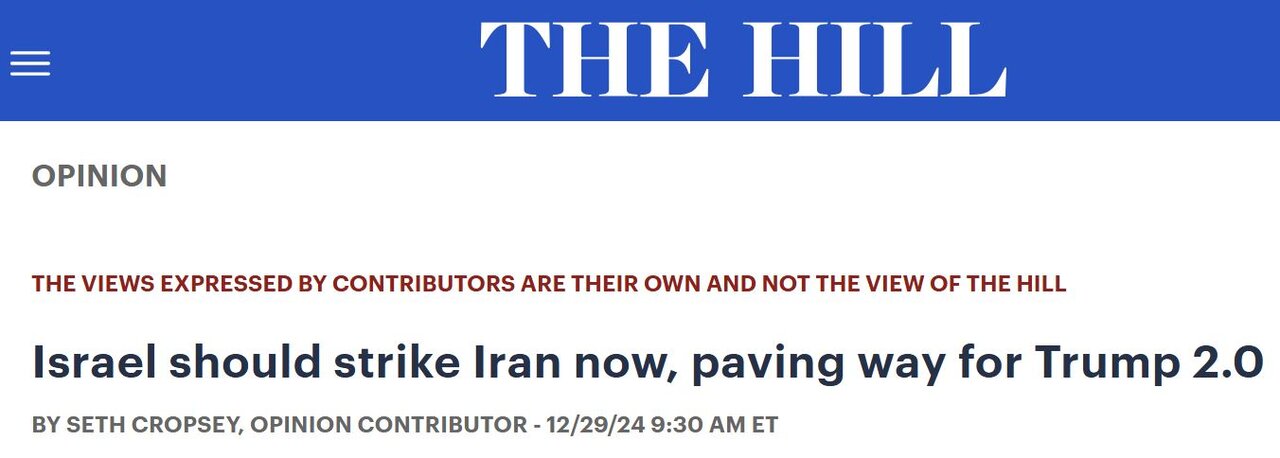TEHRAN – Seth Cropsey in his article published on The Hill, labeled Iran as the “source of warfare that has engulfed the Middle East since Oct.7, 2023.”
However, a closer examination of the region's tumultuous history challenges this assertion, revealing a far more nuanced reality.
The events of October 7, involving Palestinian resistance groups launching operations into Israeli-occupied territories, cannot be viewed in isolation.
These actions were retaliatory measures against over seven decades of systemic Israeli aggression, which has subjected Palestinians to violence, displacement, and dispossession.
The root cause of this enduring conflict lies in Israel’s policies and the unwavering support it receives from the United States, not in the actions of Iran.
As Israel’s aggressive policies in Palestine, Lebanon, and Syria, now “hints” many of us living in the region into challenging the statement made by Cropsey, a unilateral Israeli strike on Iran, as the article suggests, would only exacerbate the already-present tensions.
The U.S. policy of “maximum pressure” on Iran, promoted by the Trump administration, has similarly failed to deliver its objectives. Instead of curbing Iran’s nuclear program or diminishing its regional influence, this strategy has deepened mistrust, fostered anti-American sentiment, and strengthened Iran’s resolve to pursue economic and military self-reliance. Aligning with such a failed policy risks further isolating Israel on the global stage.
Shifting geopolitical realities
The article also overlooks the evolving geopolitical landscape in West Asia. Iran’s strategic partnerships with Russia and China provide significant counterbalance to U.S. and Israeli efforts to isolate Tehran.
These relationships, strengthened through initiatives such as the Shanghai Cooperation Organization (SCO) and long-term economic agreements, enhance Iran’s resilience against external pressures.
Regional actors, such as Saudi Arabia and the UAE, are also re-evaluating their relationships with Iran. The 2023 Saudi-Iranian agreement, brokered by China, represents a landmark shift in regional politics.
This rapprochement reduces the likelihood of Arab states supporting any Israeli military action against Iran. An Israeli strike could unravel these fragile diplomatic gains, plunging the region into deeper instability.
Overestimation of Iran’s vulnerabilities
The article portrays Iran as a state on the verge of collapse, citing challenges such as the fall of Syria’s Assad government. However, this narrative disregards Iran’s demonstrated resilience in the face of decades of economic sanctions, military threats, and political isolation.
Iran has consistently adapted to crises by diversifying its economy under sanctions, leveraging strategic alliances, and utilizing its geopolitical position. While setbacks in Syria are notable, they do not constitute an existential threat to Iran’s influence. The Islamic Republic’s strategic depth ensures that it can recalibrate and maintain its position as a key player in West Asia.
Underestimation of Iran’s deterrence capabilities
The suggestion that Iran would be unable to respond effectively to an Israeli strike is a dangerous miscalculation.
Over the years, Iran has developed a robust deterrence framework, including advanced missile technology and cyber warfare capabilities. These tools ensure that any direct military action against Iran would come at a steep cost for the aggressor.
Iran’s long-range ballistic missiles, for instance, pose credible threats to strategic targets in Israel and U.S. bases across the region. An Israeli strike would almost certainly provoke a broader regional conflict, with devastating consequences for all parties involved.
Misrepresentation of regional dynamics
The article frames the collapse of Syria’s Assad government as a critical blow to Iran’s regional strategy, ignoring the broader dynamics of Iranian foreign policy. While Syria is undoubtedly an important ally, its potential loss would not dismantle Iran’s influence across the region.
Iran’s relationships with key players like Iraq remain strong, with Tehran maintaining significant political and military influence. These alliances, coupled with Iran’s ability to adapt its strategies, underscore the article’s failure to account for the multifaceted nature of regional dynamics.
Domestic and international backlash
One of the article’s most glaring oversights is its failure to recognize the unifying effect of external aggression on the Iranian population.
Historically, foreign threats have rallied Iranians around their government, setting aside domestic grievances in favor of national unity. From the grueling Iran-Iraq War in the 1980s to enduring decades of sanctions, Iran has shown its ability to withstand external pressures, consistently demonstrating its capacity to adapt and survive.
On the international stage, an Israeli strike on Iran would likely provoke widespread condemnation. Even U.S. allies in Europe have expressed skepticism about military solutions to the Iranian question, favoring diplomatic engagement instead.
Moreover, emerging powers like China and India, which have growing economic and strategic interests in Iran, would view such an escalation as counterproductive.
As the key point that Cropsey’s article overlooks is the fact that West Asia has already suffered enough from wars, often driven by miscalculation and aggression by foreign-backed actors, a more nuanced approach would likely prove more practical and beneficial for all parties involved.
Building a sustainable future requires acknowledging the intricate realities of the region and working towards solutions that foster stability, cooperation, and peace.


No comments:
Post a Comment